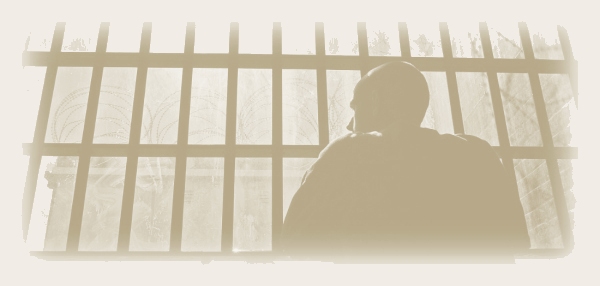Prison Life
Life in prison or State jail varies quite a bit depending on the unit, the inmate’s status, job and/or classes being taken, and the inmate’s attitude and behavior. Days start early, meal time is brief and boredom is a constant companion. Patience is tested daily. Head counts by the guards occur at all hours of the day and night. Comfort is generally not afforded, especially temperature regulation. But prison is not intended to have a country club atmosphere. Nonetheless, opportunities for education, self improvement, and faith development are available. And prison volunteers bring in much needed cheer and hope.

One former inmate described his experience:
“Upon first arrival at a high-security Texas State prison, what struck me most about my fellow inmates was their uniformity. We all wore white, making the moment seem ghostly, ominous, and otherworldly. Some of the men had shaved their heads, because with summer heat, anything that could be done to cool off counted. And there was another benefit: in a fight, an opponent would have no hair to grab.
My routine had me rolling out of bed every morning at 3:00 to eat breakfast. I left for my job between 4:30 and 5:00 a.m. Lunch in the chow hall began about 10:30; dinner was sometime between 3:30 and 5:30. The gym and the rec yard opened after that. The dayroom closed and the lights were dimmed every weekday —without fail— at 10:30 p.m.
Privacy, I learned, was monumentally valued in prison. Since real privacy is not possible, prisoners developed small courtesies that afforded us at least the illusion of privacy. We knew when to look away, when to put on a headset, when to give each other some room. One such courtesy was the unspoken rule dictating that inmates were never to look inside another man’s cell as they walked by. It was considered disrespectful. And it could be dangerous.
I learned there were unwritten rules for prison fighting —a ritual to it. These were usually just fights, not attempted murder. If a guy went down, the fight stopped. If someone stepped in to break it up, it usually stopped. Usually. If someone in the fight picked up a weapon—a tray, a chair, a book, a bench—everything changed. When a weapon entered the equation, so did the guards.
In prison, how you handled a direct challenge was everything. You stayed alive by acting like you weren’t afraid to die. You stayed safe by being reckless. And you were able to live in peace by acting like you were always ready for a fight.”
When another former inmate was asked what he thinks when it comes to prisoner rehabilitation, he said “We are all born with the ability to make our own choices, but once you make the wrong choice, other people make your decisions for you. I want prisoners to understand that it’s up to them to make the right choice.”
While prison life is difficult and potentially dangerous, many inmates find ‘shelter from the storm’ through the practice of their growing Christian faith, boosted and helped along by KPM volunteers and retreats. And the experiences with KPM help the inmates to make better and life-changing choices. Many of the retreatant inmates have found freedom in their souls while facing the loss of physical freedom. A significant number of retreatant inmates have expressed a desire to become active in KPM as outside team members upon their release from prison. That alone speaks volumes about the impact KPM is having on the lives of a large number of inmates.
For information on prison life from the TDCJ perspective, read the Offender Orientation Handbook.
Visit the link to view a very informative article on prison life written by the Houston law firm Habern, O’Neil & Associates entitled Going to Prison in Texas.
My routine had me rolling out of bed every morning at 3:00 to eat breakfast. I left for my job between 4:30 and 5:00 a.m. Lunch in the chow hall began about 10:30; dinner was sometime between 3:30 and 5:30. The gym and the rec yard opened after that. The dayroom closed and the lights were dimmed every weekday —without fail— at 10:30 p.m.
Privacy, I learned, was monumentally valued in prison. Since real privacy is not possible, prisoners developed small courtesies that afforded us at least the illusion of privacy. We knew when to look away, when to put on a headset, when to give each other some room. One such courtesy was the unspoken rule dictating that inmates were never to look inside another man’s cell as they walked by. It was considered disrespectful. And it could be dangerous.
I learned there were unwritten rules for prison fighting —a ritual to it. These were usually just fights, not attempted murder. If a guy went down, the fight stopped. If someone stepped in to break it up, it usually stopped. Usually. If someone in the fight picked up a weapon—a tray, a chair, a book, a bench—everything changed. When a weapon entered the equation, so did the guards.
In prison, how you handled a direct challenge was everything. You stayed alive by acting like you weren’t afraid to die. You stayed safe by being reckless. And you were able to live in peace by acting like you were always ready for a fight.”
I learned there were unwritten rules for prison fighting —a ritual to it. These were usually just fights, not attempted murder. If a guy went down, the fight stopped. If someone stepped in to break it up, it usually stopped. Usually. If someone in the fight picked up a weapon—a tray, a chair, a book, a bench—everything changed. When a weapon entered the equation, so did the guards.
In prison, how you handled a direct challenge was everything. You stayed alive by acting like you weren’t afraid to die. You stayed safe by being reckless. And you were able to live in peace by acting like you were always ready for a fight.”
When another former inmate was asked what he thinks when it comes to prisoner rehabilitation, he said “We are all born with the ability to make our own choices, but once you make the wrong choice, other people make your decisions for you. I want prisoners to understand that it’s up to them to make the right choice.”
While prison life is difficult and potentially dangerous, many inmates find ‘shelter from the storm’ through the practice of their growing Christian faith, boosted and helped along by KPM volunteers and retreats. And the experiences with KPM help the inmates to make better and life-changing choices. Many of the retreatant inmates have found freedom in their souls while facing the loss of physical freedom. A significant number of retreatant inmates have expressed a desire to become active in KPM as outside team members upon their release from prison. That alone speaks volumes about the impact KPM is having on the lives of a large number of inmates.
For information on prison life from the TDCJ perspective, read the Offender Orientation Handbook.
Visit the link to view a very informative article on prison life written by the Houston law firm Habern, O’Neil & Associates entitled Going to Prison in Texas.
For information on prison life from the TDCJ perspective, read the Offender Orientation Handbook.
Visit the link to view a very informative article on prison life written by the Houston law firm Habern, O’Neil & Associates entitled Going to Prison in Texas.



